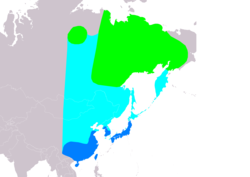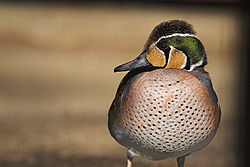Description
At between 39 and 43 centimetres (15 and 17 in), this duck is slightly larger and longer-tailed than the common teal. The breeding male is unmistakable, with a striking green nape, yellow and black auriculars, neck, and throat. It has a dark crown, and its breast is light brown with dark spots. Its grey sides are set off on the front and rear with white bars.
The Baikal teal has a height from 11.75 to 15.75 inches and a weighs an average of 1 pound.
The female looks similar to a female green-winged teal but with a longer tail, and a distinctive white spot at the base of the bill and a white throat that angles to the back of the eye. She also has a distinct light eyebrow bordered by a darker crown. The underwing is similar to the Green-winged Teal also, but has a darker leading edge. The green speculum has an indistinct cinnamon-buff inner border. [9] Some "females" have "bridle" markings on their faces, but it has been suggested that at least some of these bridled "females", if not all, are in fact juvenile males. [9] The juvenile has a plumage similar to that of the female and can be distinguished from the Common Teal by the pale loral spot.
In non-breeding (eclipse) plumage, the drake looks more like the female, but plumage is a much richer reddish-brown (rufous) colour.
Distribution and habitat
It breeds within the forest zone of eastern Siberia from the Yenisey basin eastwards to Kamchatka, northern Koryak, eastern Magadan Oblast, northern Khabarovsk Krai, southeastern and northern Sakha east central Irkutsk Oblast, and northern Krasnoyarsk Krai. It is a migratory species, wintering in South Korea, Japan, Taiwan, northern and eastern China, from Beijing down the coast to the Vietnam border, and west to Yunnan then north to Chongqing and Henan. [1] [10]
It breeds in pools on the tundra edge and within swampy forests. In winter it is found on lowland fresh waters.
This page is based on this
Wikipedia article Text is available under the
CC BY-SA 4.0 license; additional terms may apply.
Images, videos and audio are available under their respective licenses.








